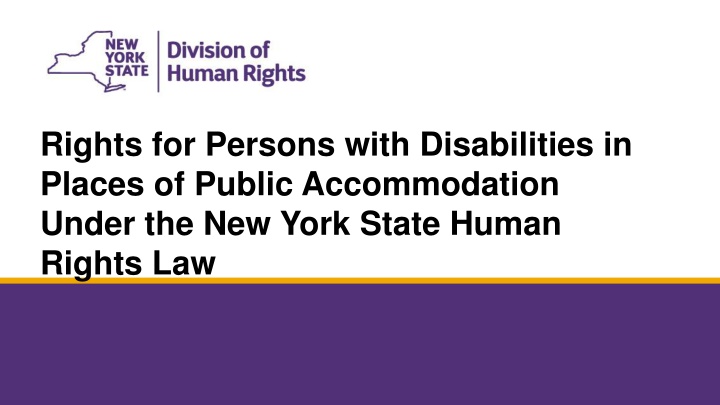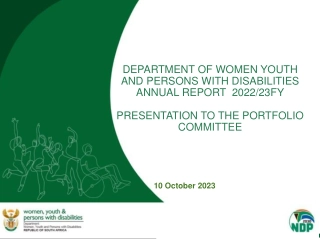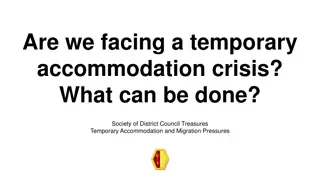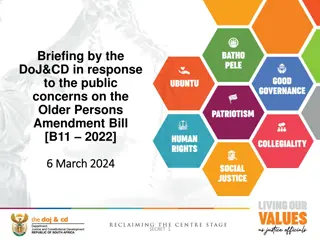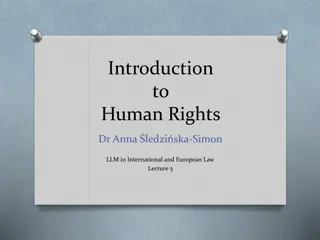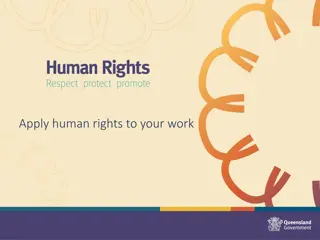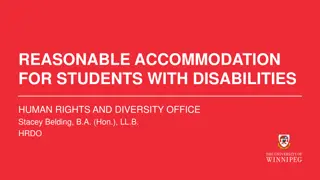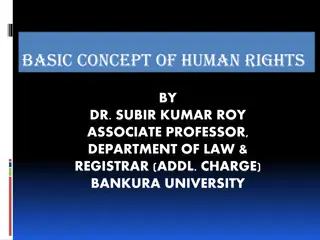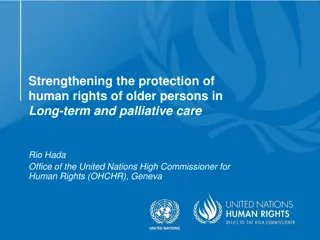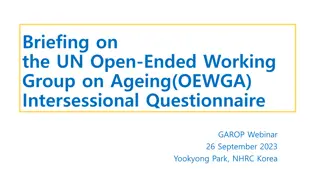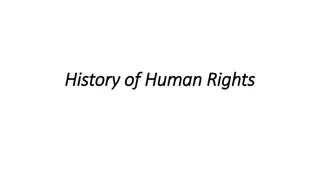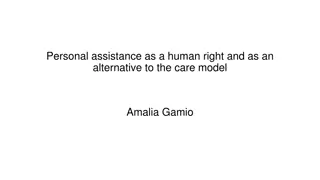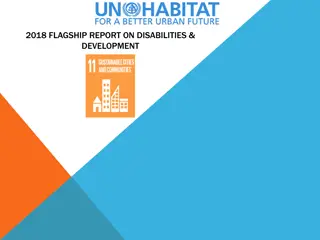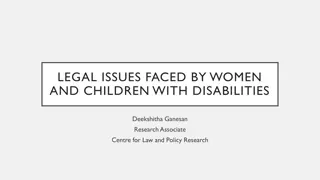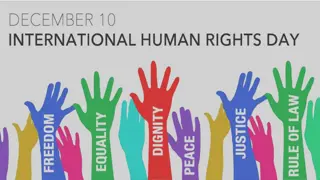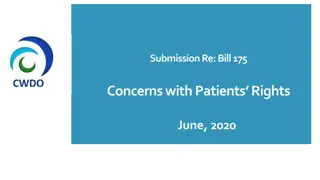Rights for Persons with Disabilities in Public Accommodation Under NY Human Rights Law
Learn about the protections and definitions of disabilities under the New York State Human Rights Law (NYSHRL) compared to the Americans with Disabilities Act (ADA). Discover what constitutes a place of public accommodation, enforcement by the NY Division of Human Rights, and website accessibility guidance.
Download Presentation

Please find below an Image/Link to download the presentation.
The content on the website is provided AS IS for your information and personal use only. It may not be sold, licensed, or shared on other websites without obtaining consent from the author.If you encounter any issues during the download, it is possible that the publisher has removed the file from their server.
You are allowed to download the files provided on this website for personal or commercial use, subject to the condition that they are used lawfully. All files are the property of their respective owners.
The content on the website is provided AS IS for your information and personal use only. It may not be sold, licensed, or shared on other websites without obtaining consent from the author.
E N D
Presentation Transcript
Rights for Persons with Disabilities in Places of Public Accommodation Under the New York State Human Rights Law
2 What will be covered? What types of conditions/impairments are covered as disabilities under the New York State Human Rights Law (NYSHRL)? How does the NYSHRL differ from the Americans with Disabilities Act (ADA) in protections for persons with disabilities?
3 What will be covered? What is a place of public accommodation under the NYSHRL? What type of discrimination is prohibited? Division Initiated Investigation Work. How does the New York State Division of Human Rights enforce the NYSHRL?
4 Definition of Disability under NYSHRL physical, mental or medical impairment resulting from anatomical, physiological, genetic or neurological conditions which prevents the exercise of a normal bodily function or is demonstrable by medically accepted clinical or laboratory diagnostic technique, or; a record of such an impairment, or; a condition regarded by others as such an impairment.
5 Definition of Disability under Americans with Disabilities Act (ADA) The ADA defines disability as a substantial limitation of a major life activity. The definition of disability under the NYSHRL is more broadly construed and does not require the impairment to be substantial nor affect a major life activity.
6 Place of Public Accommodation Defined Places of Public Accommodation as defined under the NYSHRL cover most businesses and places that are open to the public, including: Hotels, motels Restaurants, diners & bars Retail stores Health clinics & hospitals Movie theatres Amusement and recreation parks State and local government entities Websites
7 Website Accessibility DOJ Guidance DOJ has taken the position that the ADA s requirements apply to all the services, programs, or activities of state and local governments, including those offered on the web.
8 Website Accessibility DOJ Guidance DOJ has taken the position that the ADA s requirements apply to all the goods, services, privileges, or activities offered by public accommodations, including those offered on the web.
9 Website Accessibility DOJ Guidance Guidance found at https://beta.ada.gov/web- guidance/ Challenge remains what standard?
10 Places of Public Accommodation Places of public accommodation are obligated to ensure access to goods, services and facilities by making reasonable accommodations for persons with disabilities.
11 Reasonable Modifications of Rules, Practices or Procedures Examples of modifying a rule, practice or procedure to provide access include: Implementing policies to ensure staff are trained to assist and accommodate persons with disabilities to access goods, services, or facilities within a place of public accommodation. Provide curb-side service or home delivery of goods or services where it is reasonable to do so.
12 G/H/S Dogs Places of Public Accommodation Persons accompanied by their professionally trained guide, hearing or service dog may not be discriminated against in any area of DHR s jurisdiction, including employment, housing, and public accommodations (296.14). This is not a reasonable accommodation standard. There is no undue hardship analysis.
13 296.14 Dog 296.14 states that in addition to reasonable accommodations for persons with disabilities, it shall be an unlawful discriminatory practice for any covered person to deny access or otherwise discriminate against a blind person, a hearing impaired person or a person with another disability because he or she is accompanied by a dog that has been trained to work or perform specific tasks for the benefit of such person by a professional guide dog, hearing dog or service dog training center or professional guide dog, hearing dog or service dog trainer.
14 Dog Trainers Covered In addition, it is unlawful to discriminate against a professional guide dog, hearing dog or service dog trainer engaged in such training of a dog for use by a person with a disability, whether or not accompanied by the person for whom the dog is being trained.
15 Investigation 1. Is it a dog? Yes. 2. Has it been professionally trained to be a G/H/S dog? Yes We have a 296.14 dog. 296.14 dog goes where the person goes. No reasonable accommodation analysis necessary.
16 296.14 Service Dogs Dog that has been professionally trained to provide a service to an individual with a disability. (Examples) Professionally trained to: Calm a person with PTSD down by engaging in an activity that interacts/calms individual down. Alert an individual to take medications for hypertension, seizure disorder. Interact with a person with autism to mitigate or eliminate impairing affects of autism. Assist person with dexterity and/or mobility impairments to fetch and/or operate items.
17 296.14 Service Dogs Emotional support / companion dogs are NOT service dogs in public accommodations cases. NYSHRL has adopted ADA requirements = service animal are dogs or miniature horses. Does not include emotional support or companion dogs.
18 Public Accommodations & Service Animals The person using a service animal has the right to take the animal with them into all areas normally open to the public. Individuals using a service animal may not be isolated, seated in a segregated area, or otherwise less favorably treated. Establishments that sell or prepare food must allow service animals in public areas even if state or local health codes prohibit animals. Allergies and fear of dogs are not valid reasons for denying access or refusing service to people using service animals.
19 Public Accommodations & Service Animals The regulations state specifically, with regard to control of the service animal that the service animal shall have a harness, leash, or other tether, unless either the handler is unable because of a disability to use a harness, leash, or other tether, or the use of a harness, leash, or other tether would interfere with the service animal's safe, effective performance of work or tasks, in which case the service animal must be otherwise under the handler's control.
20 Public Accommodations & Service Animals A service animal may be required to be removed from the premises if the animal is out of control and the animal's handler does not take effective action to control it. Furthermore, the care and control of the animal is entirely the responsibility of the handler, and the public accommodation is not responsible for any care or supervision of a service animal.
21 Public Accommodations & Service Animals The individual using a service animal has the right to be free from inquiries regarding his or her disability. The public accommodation may make limited inquiries, specifically, if the animal is required because of a disability and what work or task the animal has been trained to perform. A public accommodation shall not require documentation, such as proof that the animal has been certified, trained, or licensed as a service animal.
22 Public Accommodations & Service Animals Generally, a public accommodation may not make these inquiries about a service animal when it is readily apparent that an animal is trained to do work or perform tasks for an individual with a disability. A fee cannot be charged for the presence of a service animal, even if the public accommodation normally charges a fee for the presence of a pet. Likewise, it is unlawful to impose any other requirement because of the presence of the animal, such as a deposit in case of damage.
23 Auxiliary Aids & Services Places of Public Accommodation must take such steps to ensure that no individual with a disability is excluded or denied services because of the absence of auxiliary aids and services, unless such person can demonstrate that taking such steps would fundamentally alter the nature of the public accommodation or would result in an undue burden.
24 Auxiliary Aids & Services Examples of auxiliary aids and services include: sign language interpreters; materials in alternative format; acquisition or modification of equipment or devices
25 Removal of Architectural Barriers under the NYSHRL Places of public accommodation must remove architectural barriers where it is readily achievable to do so, in order to make their premises accessible to persons with disabilities.
26 Readily Achievable The NYSHRL defines readily achievable as, easily accomplishable and able to be carried out without much difficulty or expense.
27 Removal of Architectural Barriers under the NYSHRL Examples of barrier removal include: installation of a ramp; widening of doorways or check out aisles, or lowering service counters to make them accessible to a wheelchair user; making curb cuts in sidewalks and entrances;
28 Removal of Architectural Barriers One-Step Campaigns Division Initiated Investigations Unit Main Street Investigations Low Hanging Fruit Work with Local Building Departments Work with Chambers of Commerce Service and the Delivery of Goods in the Time of COVID-19 Filing Complaints
29 Filing a Complaint The Division of Human Rights has regional offices around the state. Contact info for DHR s reginal offices is located at www.dhr.ny.gov/contact-us Complaint forms are available at www.dhr.ny.gov/complaint. A complaint must be filed with the Division within one year of the occurrence of the discrimination. Complaints may be filed directly in state court, within three years of the alleged discrimination. Complaints may not be filed in both the Division and state court.
30 Filing a Complaint Complaint forms are available at: www.dhr.ny.gov/complaint.
31 Investigative Determination Based on all the evidence collected by the investigator, the Regional Director will decide as to whether there is probable cause to believe that discrimination occurred. If the Regional Director determines that there is no probable cause to believe that discrimination occurred, the complaint is dismissed, and the Complainant may appeal the dismissal to state court. If there is a determination of probable cause, the case is forwarded for a public hearing before an Administrative Law Judge.
32 Public Hearing At the public hearing before an Administrative Law Judge, testimony is taken under oath, witnesses may be called to testify, and a full record is made. Complainant may be represented by his or her own attorney, or a Division attorney will be appointed to present the case in support of the complaint. The Administrative Law Judge submits a Recommended Order for the Commissioner s consideration.
33 Final Orders and Remedies The Commissioner reviews all submissions, relevant evidence and the Recommended Order, and issues a Final Order either finding discrimination or dismissing the Complaint. Where the Commissioner finds that discrimination has occurred, remedies may include: an order to cease the discriminatory policies; reinstatement to a job, with back pay; housing accommodation; access to goods and services from a public accommodation; reasonable accommodation or modification a requirement that training be conducted; civil fines and penalties.
34 Contact Info If you d like connect with the Division afterwards with questions or requests, call us at 1-888-392-3644 or email us at info@dhr.ny.gov. DHR s Director of Disability Rights, John Herrion, can be contacted at john.herrion@dhr.ny.gov, or 718-741-8332.
35 Questions/Contact us Call Email Visit Follow Call DHR at 1-888-392-3644 Email us at info@dhr.ny.gov Visit dhr.ny.gov Follow @NYSHumanRights on YouTube, Twitter, Facebook, Instagram, & LinkedIn
